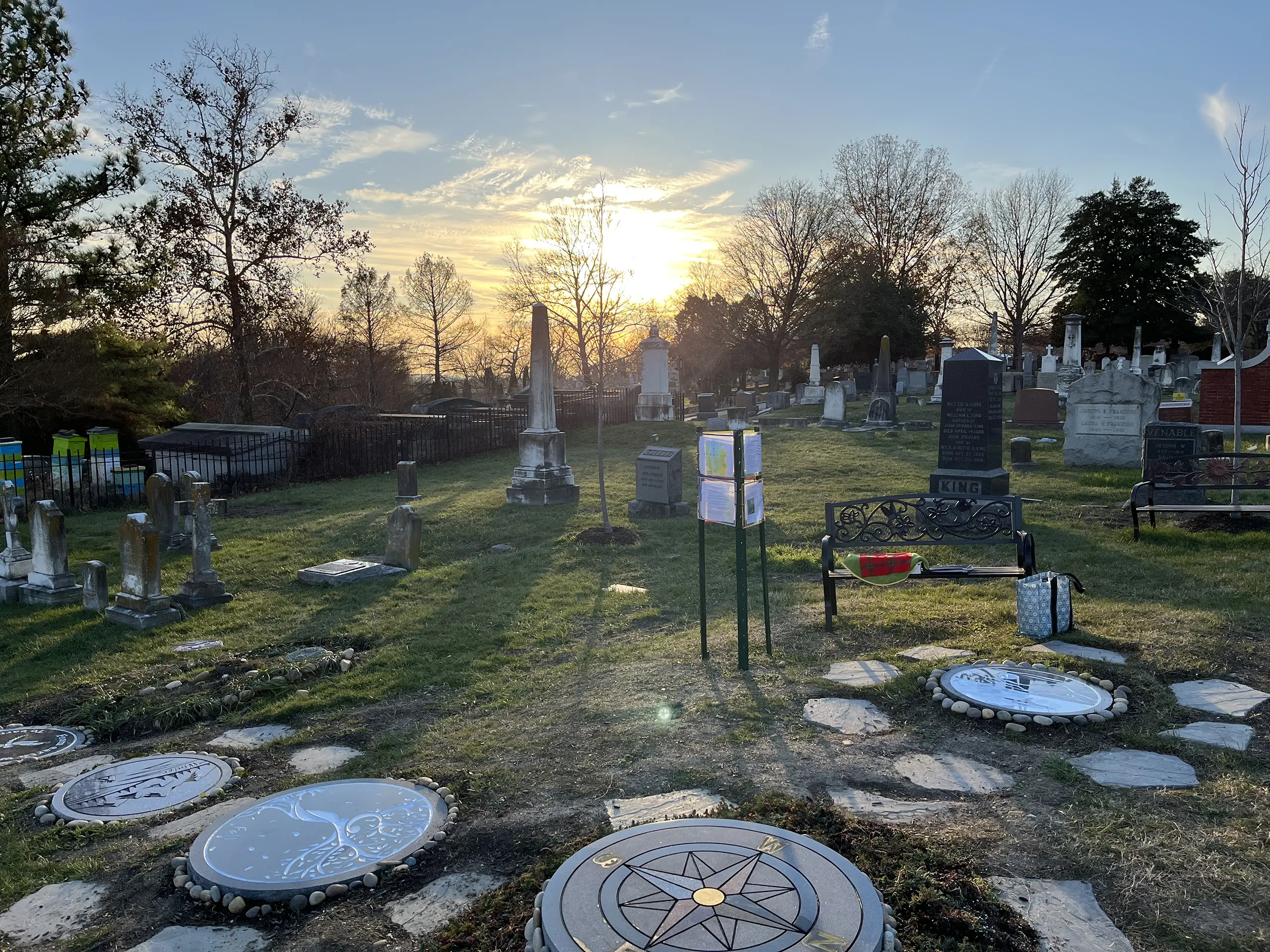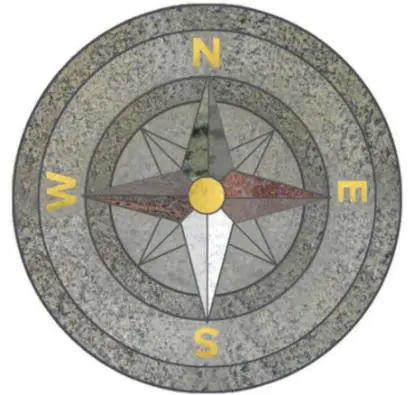Please join Congressional Cemetery and the designers of the Circle of Life for an outdoor dedication ceremony honoring the creation of this signature cemetery fixture. The event coincides with the Vernal Equinox, a time to celebrate nature’s renewal and longer days as the sun crosses the celestial equator.
The Circle of Life is a living monument to nature. Surrounded by linden trees, the contemplative site invites visitors to meander along stepping stone paths among engraved granite circles that depict the natural life cycle. The open slope and compass rose centerpiece provide a unique vantage point to follow the sun’s movement during solstice and equinox seasonal changes.
Featuring:
— Batalá — all-women Afro-Brazilian marching band playing Samba-Reggae rhythms
— A laying of stones ceremony
— An informal auction for bench naming rights
— Refreshments
For this event, the Batalá drummers will lead those who wish to gather at the gate at 3pm — for a rousing rhythmic walk from the cemetery entrance to the southeast hillside above the mausoleums, where the dedication program will take place.
An informal auction will be included giving you an opportunity to bid on having your name (or names) inscribed on a medal plate to sponsor one of the garden benches within the Circle.
The event is free to attend but we request that you RSVP HERE if you plan to attend.
Please feel free to read more from the Circle of Life designers below or click here to download the PDF!
The Circle of Life is a living monument to nature. A contemplative space for expressing gratitude that life will be replenished, the seasons will change, and the sun will rise tomorrow. The interpretive environment is defined by:
- steppingstone paths for meditative walks among artisan stone works with scenes from nature;
- a 60’ circle of linden trees aligned with the directional points of a compass rose centerpiece;
- full horizon vantage point to observe the sun’s celestial path during solstices and equinoxes;
- a celebratory circle in tribute to past and future stewards of the land and surrounding burial sites;
- a peaceful space with garden benches for reflection in situ.
congressionalcemetery.org/Circle-of-Life

The Cemetery’s outdoor monument is designed to enhance the natural environment of this National Historic Landmark. Facing the southern horizon, the hillside memorial offers full views of sunrise and sunset. Over centuries, ancient civilizations and Native Americans have created circular spaces in such open landscapes to follow the sun’s movement and celebrate celestial moments in time.
Establishing a natural boundary for the Circle of Life, eight linden trees were planted in a 60’ circle corresponding with the eight directional points of the compass rose (North, South, East, West, NE, NW, SE, SW) to follow the sun’s trajectory. Over the coming decades the trees will provide a serene spot to rest beneath their shading canopy. Every spring and summer, the flowering linden branches laden with scented blossoms will be a rich source of nectar for the nearby beehives.
The Circle of Life is in the cemetery’s SE quadrant on the hillside above the family vaults
Steppingstone paths wander among granite engravings and scenes of nature. The trees, stoneworks and open horizon invite visitors to pay homage to the environment by stopping, listening, walking, and observing the surrounding flora and fauna. The slope overlooks humming beehives, a row of venerable family tombs and a pet cemetery. In the distance beyond the tree line is the confluence of the Anacostia and Potomac Rivers.

Not unlike the rituals of Stonehenge, visitors can celebrate the change of seasons by tracking the sun’s path across the aligned symmetry of the circular ‘tree-henge.’ The summer solstice begins its long day’s journey from the NE linden tree. The sun intensifies and then mellows as it finally casts a shadow across the NW tree 16 hours later. The winter solstice dims the light and shortens the SE to SW solar track across the Circle’s southern horizon in just over 10 hours.
Welcome rays of sun spread dancing tree shadows across the arc of the Circle during the vernal (spring) and autumnal (fall) equinoxes. Twice a year, day and night are of equal lengths as the sun rises above the east tree, moves directly across the center of the compass rose, and sets 12 hours later beyond the west tree.
COMPASS ROSE & NATURE ENGRAVINGS

The compass ‘rose of the winds’ was used by ancient Greek mariners to chart their course at sea. Each star point of this terrestrial centerpiece radiates to the trunk of the corresponding tree around the Circle’s perimeter.
Along the north to south axis of the Circle, and surrounding the centerpiece, are eight engraved roundels that present a visual narrative of earth’s natural cycles. The 30” granite medallions portray the four seasons, flora and fauna, and sunrise and sunset. As simple contemporary depictions, the rock carvings are somewhat akin to the petroglyphs left by indigenous peoples to teach, warn, or pass on significant messages to their descendants.
Four centuries ago, Piscataway and Anacostan tribes inhabited and roamed this area and left artifacts and hammered stones – later unearthed along the banks of the Potomac and Anacostia Rivers. Succeeding generations may interpret this sacred space and the granite engravings found within the Circle of Life as an appeal to environmental stewardship at a time when warming climate and pollution threaten our society.

Natural or ‘green’ burials are designed to have minimal environmental impact and conserve earth’s resources. Congressional is the only cemetery in Washington DC that offers this eco-friendly option for interment. In keeping with its ecological focus, the Circle of Life is a living memorial to those who choose this simple and sustainable end to their existence.
In a typical green burial, the body is not cremated, prepared with chemicals, or buried in a concrete vault. It is simply placed in a biodegradable container or shroud and interred in a gravesite to decompose fully and return to nature.
The natural and organic disposition of one’s body is a gift to the earth – one that connects our end to the beginning of life for other living organisms. Science tells us that energy and matter cannot be created or destroyed, only converted from one form to another. Green burial eases the transformation of biomass, contributing to the complex ecosystem that continues the cycle of life.
BACKGROUND & COLLABORATORS
Plans for the Circle of Life memorial began in 2019. A group of friends, interested in the history of Congressional Cemetery and in green burial, worked with cemetery staff to designate a space to honor environmentally friendly interment.
In partnership with Casey Trees, linden trees were planted on the hillside to create a sylvan outdoor sanctuary within the cemetery’s hallowed grounds.
The granite stones were sourced, engraved, and installed by FRAM Monuments, a local business providing memorial monuments to the Washington Baltimore community for over 100 years.
Graphic designer and photographer David Posey of Alexandria, VA, graphically adapted selected images to produce the vector line art for the granite engravings.
In partnership with Congressional Cemetery, the Circle of Life was created and funded by Sharon Metcalf and Circle collaborators — Nancy Brennan, Kay Tatum, Mary Kay Blake and Margaret Tobey, all of whom have chosen gravesites within the Circle for their final resting place. For more info, email metcalf.sharon@gmail.com
The circle of trees, engraved stones, and native plantings are a gift to preserve the cemetery’s natural environment for generations to come. congressionalcemetery.org/circle-of-life

Congressional Cemetery, a National Historic Landmark in Washington DC, lies just one mile SE of Capitol Hill.. The 35-acre functioning cemetery, memorial park, and active public space, serves as the final resting place for senators, congressman, Native American diplomats, notables including John Philip Sousa, Mathew Brady, and J. Edgar Hoover, and public citizens. Established in 1807, the cemetery continues its traditions today to provide funeral ceremonies for those wishing to be buried among the 65,000 designated gravesites. Congressional is also known throughout the city for its ongoing series of annual events, Soul Strolls, Twilight Tours, Cinematery movie nights, and other community programs.
Click here to download the Circle of Life PDF











